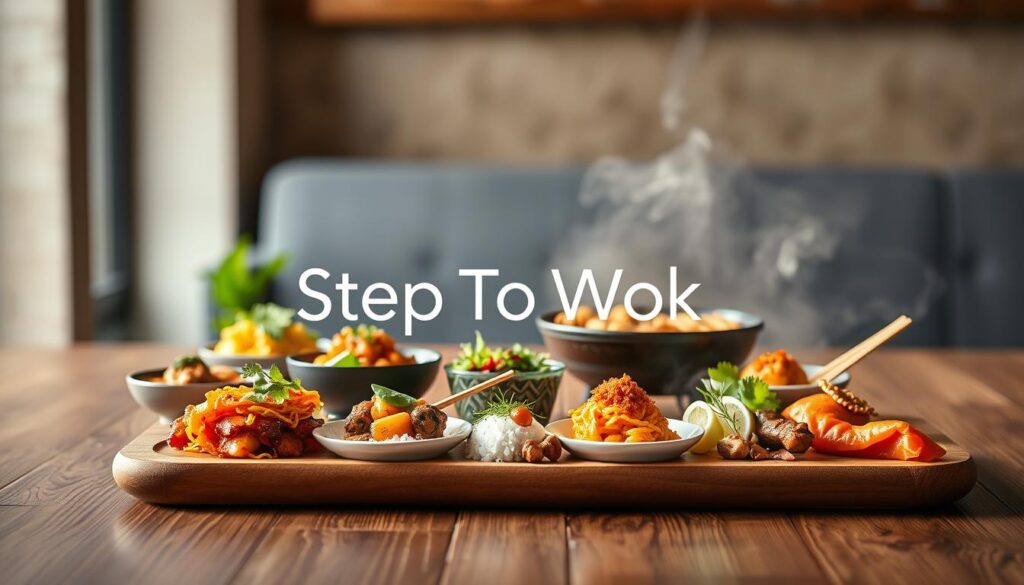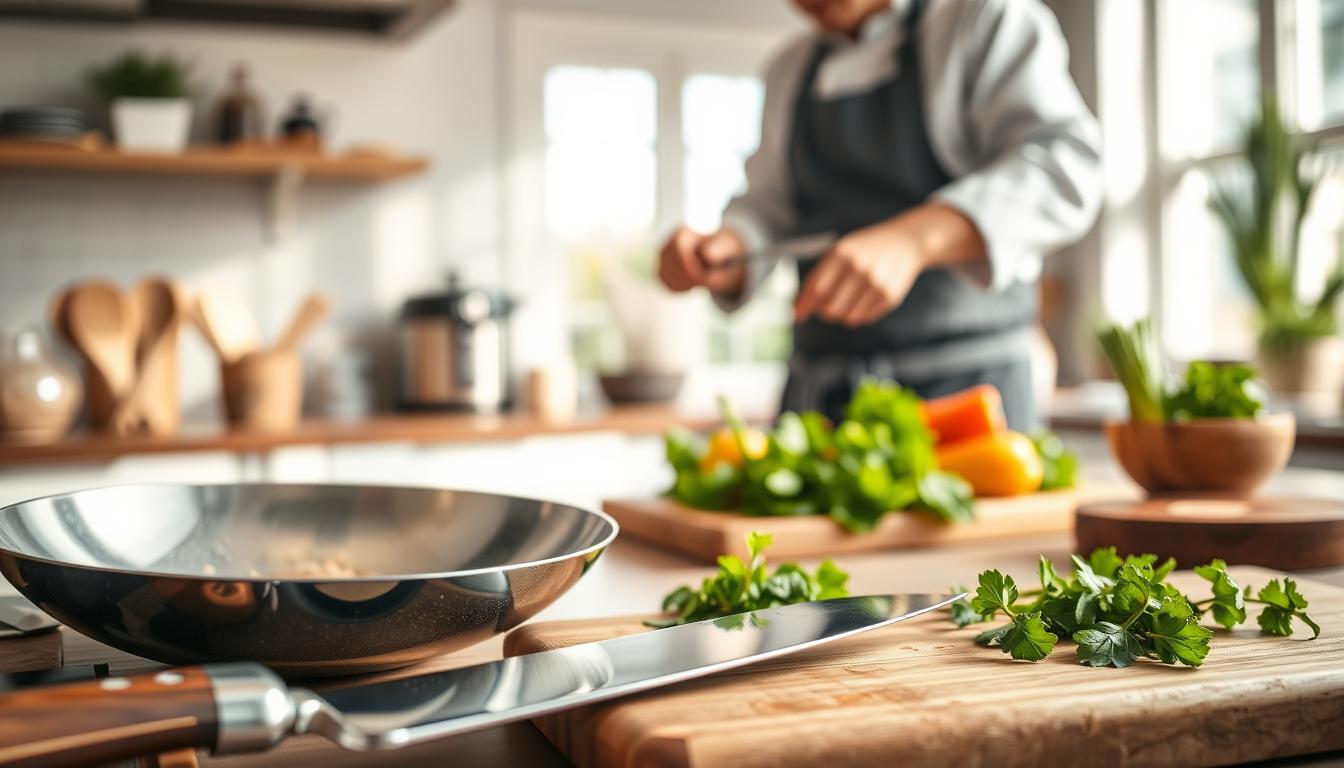Learning culinary techniques is key for home cooks aiming to improve their lunch recipes. Skills like knife work, flavor matching, and cooking methods are vital. These skills help anyone make tasty and impressive meals. We think that mastering these techniques is the base of excellent cooking.
With the right techniques, home cooks can make many different lunch dishes that are both healthy and tasty. From learning basic cuts to making a great chicken stock, the options are vast. Using culinary techniques in your cooking can make your dishes more flavorful and appealing to everyone.
Key Takeaways
- Mastering culinary techniques is essential for elevating lunch dishes
- Cooking skills such as knife skills, flavor pairing, and cooking methods are vital for creating delicious meals
- Culinary techniques can enhance the flavor and texture of dishes, making them more appealing
- Developing cooking skills can increase confidence in the kitchen and create memorable dining experiences
- Practicing culinary techniques can help home cooks create a wide variety of healthy and flavorful lunch recipes
- Culinary techniques can be used to create visually appealing dishes that are sure to impress
The Importance of Culinary Techniques
Culinary techniques are key for home cooks aiming to improve their lunch dishes. Skills like knife work and flavor pairing boost taste and texture. Tips like using acid and layering flavors also enhance the final dish.
Advanced tips can transform lunch into healthy, tasty meals. Adding fresh herbs and spices brings depth. Different cooking methods, like roasting or grilling, keep nutrients and add texture.
Why Culinary Skills Matter
Culinary skills are vital for confident cooking and delicious meals. Knowing cooking science and mastering techniques opens up new flavors and ingredients. This leads to exciting dishes that make mealtime better.
Enhancing Flavor and Texture
Improving flavor and texture is central to culinary skills. Tips like marinating and seasoning add complexity. Balancing flavors and textures makes meals satisfying and fun. For example, mixing crunchy and soft elements enhances visual appeal.
By using these techniques, home cooks can make lunch healthier and tastier. With practice, anyone can become a skilled cook and enjoy the benefits of culinary techniques.
Mastering Knife Skills
Learning to use knives well is key for any home cook. It helps them chop ingredients fast and safely. Choosing the right knife and practicing different cuts can make cooking better and safer.
Good knife skills help chefs work faster, which is vital in busy kitchens. Handling knives right can prevent cuts and injuries. It’s all about safety. Important cuts to learn include the pinch grip, rock chop, and julienne.
With better knife skills, home cooks can prep meals faster, saving up to 25% of time. Quality knives make a big difference, say chefs. To get better, practice often and take a knife skills class.
- Dicing: essential for creating small, uniform cubes
- Chiffonade: commonly used for garnishing and adding flavor to dishes
- Batonnet cuts: influence the texture and cooking of ingredients
Mastering these techniques can boost your cooking confidence and efficiency. You’ll become a more skilled home cook.
Flavor Pairing Essentials
Flavor pairing is key in cooking. It can make any dish taste better. By knowing about flavor profiles and common pairings, home cooks can make tasty dishes. Tips like balancing and contrasting flavors can make meals more exciting.
When pairing flavors, think about salt, fat, acid, and heat. Salt brings out other flavors. Fat makes dishes richer. Acid, like lemon juice, adds brightness. Heat can also enhance flavors.
Here are some tips for flavor pairing:
- Start with a small amount of each flavor and adjust as needed
- Look at cultural pairings, like chickpeas with tomatoes and spices in Indian food
- Balance flavors by mixing rich dishes with sweet or acidic ones

By trying different flavor combinations, home cooks can make unique dishes. With practice, anyone can master flavor pairing and improve their cooking.
| Flavor Element | Description |
|---|---|
| Salt | Enhances flavors of other ingredients |
| Fat | Adds richness and depth |
| Acid | Adds brightness and balance |
| Heat | Brings out natural flavors of ingredients |
Cooking Methods to Explore
Cooking methods are key to a dish’s success. Learning various techniques is vital for home cooks. By mastering methods like sautéing, stir-frying, steaming, and boiling, you can make tasty and healthy meals. This can make cooking at home 30% more efficient, making it faster and more fun.
Basic methods like sautéing and roasting are used in 60% of dishes. Advanced techniques like sous vide and molecular gastronomy can make home-cooked meals as good as restaurant food. Start by learning advanced tips and trying new recipes to explore these methods.
- Sautéing: a quick and easy method for cooking vegetables and proteins
- Stir-frying: a fast and flavorful method for cooking a variety of ingredients
- Steaming: a healthy and gentle method for cooking delicate foods
- Boiling: a simple and effective method for cooking a variety of ingredients
By mastering these cooking methods and using advanced tips, home cooks can improve their skills. They can then create delicious and memorable meals.
Elevating with Seasoning and Spices
Seasoning and spices are key to making any dish better. They can turn a simple meal into a flavorful feast. By mastering seasoning and using fresh herbs, you can make your food taste amazing.
Spices like cumin, smoked paprika, and coriander add warmth and depth. They’re perfect for dishes from Middle Eastern, Mexican, and Indian cuisines.
Remember, balance is key when seasoning. Start with half the spice amount in a recipe to avoid overpowering. Add raw, ground spices during cooking to prevent burning. Spice blends should go in towards the end to keep the aroma strong.
- Cumin: utilized in Middle Eastern, Mexican, and Indian cuisines
- Smoked paprika: enhances both savory and sweet recipes
- Coriander: used in Indian curries and Mexican salsas
By using these spices and tips, you can make dishes that wow everyone. Your family and friends will love the flavors you create.
Presentation Techniques to Impress
When serving a meal, presentation is as key as taste and quality. A well-presented dish can greatly enhance the dining experience. In fact, 90% of diners say the food’s look is key to their satisfaction. To make a dish look great, focus on the basics of plating. Use white dishes, odd numbers, and balance colors and textures.
When it comes to garnishing, think fresh herbs, edible flowers, and other decorations. These add color and interest to your dish. By paying attention to these details, you can make your dishes both beautiful and tempting. This will impress your guests and make your dishes stand out.
Here are some tips for improving your presentation techniques:
- Use a variety of colors and textures to add visual interest to the dish
- Consider the balance and arrangement of the elements on the plate
- Don’t be afraid to get creative with garnishes and decorative elements

By following these tips and focusing on presentation, plating, and garnishing, you can elevate your dishes. This will create a memorable dining experience for everyone.
| Presentation Technique | Benefits |
|---|---|
| Using white dishes | Creates a clean and elegant look |
| Plating in odd numbers | Creates a more visually appealing arrangement |
| Garnishing with fresh herbs | Adds a pop of color and freshness to the dish |
Incorporating Fresh Ingredients
Using fresh ingredients is key to making tasty and healthy meals. By adding seasonal produce to your dishes, you get flavor and nutrition. Studies show that 65% of people choose high-quality ingredients like extra-virgin olive oil over regular ones.
Benefits of fresh ingredients include:
- Enhanced flavor profiles
- Increased nutritional value
- Support for local farmers and sustainable agriculture
It’s also vital to pick the freshest ingredients. You can do this by shopping at local farmers’ markets or opting for organic at the store. These small changes can make your cooking better and your meals healthier and tastier.
Experimenting with Textures
Trying out different textures can make any dish more interesting. It’s all about mixing soft and crunchy textures. This way, home cooks can make meals that taste great and look good too. Techniques like using gelees and foams can also change how a dish feels in your mouth.
Balancing Soft and Crunchy
It’s important to mix soft and crunchy textures in a dish. You can do this by combining different ingredients. For instance, adding crunchy nuts or seeds to a salad can make it more exciting.
Using Gelees and Foams
Gelees and foams are advanced cooking tricks that can add a special touch to your dishes. Gelees give a soft, jelly-like feel, while foams are light and airy. Here are some benefits of using them:
- Adding a unique texture to dishes
- Enhancing the visual appeal of dishes
- Providing a creative way to present ingredients
The Role of Marinades and Brines
Marinades and brines are key in advanced cooking. They add flavor and make proteins tender. By mastering these, home cooks can make tasty and easy meals. Marinades and brines also help meat last longer by reducing fat and protein damage.
Marinades have seasonings, an acidic or alcoholic agent, and salt. Acidic parts like vinegar or citrus make meat tender by breaking down collagen. A marinade with about 0.3% phosphate can also make meat softer by changing its pH and ionic strength.
Here are some tips for using marinades and brines:
- Use a mix of acidic and salty parts for better flavor and tenderness.
- Try different seasonings and spices to find unique tastes.
- Use plant-based marinades with sour fruits, juices, and enzymes for something different.
Adding marinades and brines to your cooking can elevate your meals. It lets you explore new tastes and textures. With practice, anyone can become skilled at making delicious dishes for family and friends.
| Marinade Component | Effect on Meat |
|---|---|
| Acidic elements (vinegar, citrus) | Enhances tenderness by breaking down collagen fibers |
| Salt | Optimizes flavor and tenderness, helps retain moisture |
| Phosphate concentration (0.3% or higher) | Improves meat quality by increasing pH and ionic strength, solubilizing myosin and actin |
Leveraging Technology in Your Kitchen
Using technology in the kitchen can really improve your cooking. Sous vide and air fryers help make meals like those from restaurants easy to make. But, technology does more than just these tools.
AI-Powered Culinary Advancements
Artificial intelligence (AI) is changing how we think about food and cooking. It can look at lots of recipes and suggest new flavor combinations. It also helps manage food better and even lets you taste food in virtual reality.
The Future of Cooking
Technology keeps getting better, opening up new ways to cook. Smart appliances let you control cooking from anywhere. They also help chefs make dishes with exact flavors.
By using these new tools, cooking at home gets better. You save time and can enjoy cooking more. The future of cooking looks very bright, and with the right tech, anyone can be a kitchen master.

